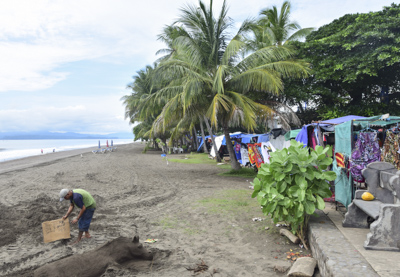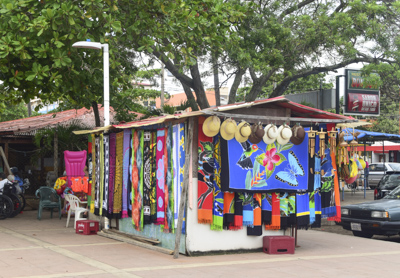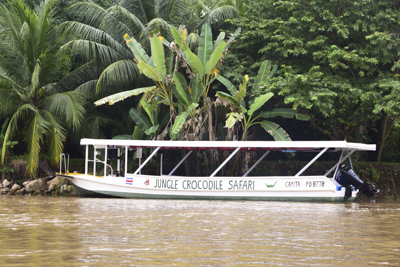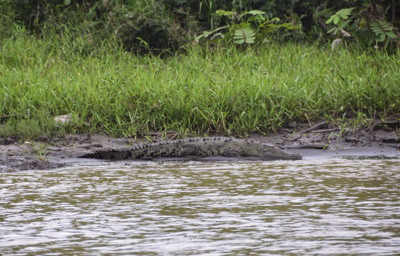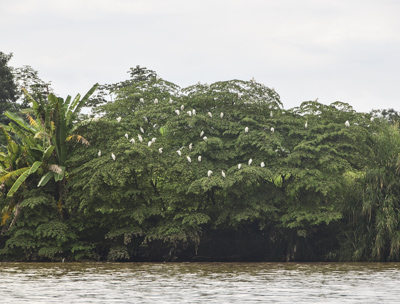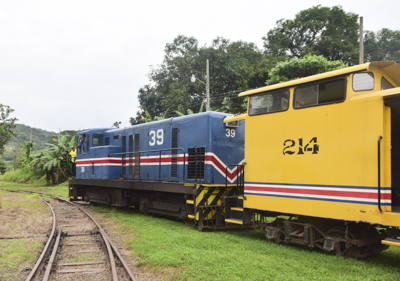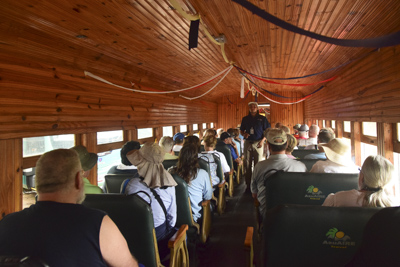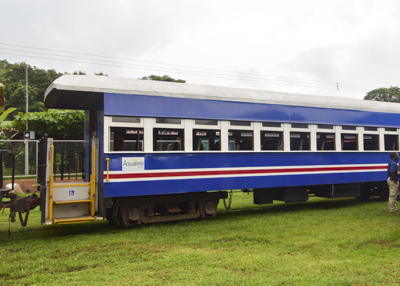Tuesday, December 13, 2016 Mostly cloudy, humid 83 degrees
Another pre-dawn arrival and the Island Princess was tied to a long cement pier when I awoke about eight o’clock.
The town of Puntarenas, or “sand point” in Spanish, is actually a protected harbor and narrow peninsula of sand jutting out into the Gulf of Nicoya, near the Pacific Ocean. About a hundred thousand people live in the immediate area and Puntarenas is the closest coastal town to the capital city of San Jose, Costa Rica.
Although Puntarenas was discovered in 1522, it was not developed until 1840 when coffee production grew. We walked off the ship and down the long pier to see the town. Stalls were arranged along the brown-sand beach with vendors selling Costa Rican souvenirs.
We took pictures and walked to the end of the public area. Daytime temperatures range from 86 to 95 degrees with high tropical humidity. We rested in a plaza which was decorated with cannons and we happily discovered free wifi. I quickly sent emails home and then we returned to the ship to prepare for our group excursion from Puntarenas to Caldera.
Our guide, “Yonathan,” was a young Costa Rican man sporting long dreadlocks. We boarded a bus for an hour-long ride to the jungle crocodile safari boat along the Rio Grande de Tarcoles or Tarcoles River. Although it is “the most contaminated river in Costa Rica,” the Tarcoles was a habitat for American crocodiles, large iguanas, and abundant waterfowl and wading birds.
As Jeff and I boarded the open boat in the sweltering heat, the African Queen came to mind and I felt like Hepburn and Bogart embarking on an adventure. The scenery was the same as in the movie!
Yonathan handed out a birding guide as we settled into our seats and the vessel slowly glided through murky waters. The skipper, Jose, was good at finding wildlife along the shore and pulled the boat as close to shore as he could, toward a variety of birds, crocodiles, and lizards.
After we returned to shore without feeding ten-foot long crocodiles, we cooled off in the air-conditioned bus on our way to a restored historic train. Coffee production, which began in Costa Rica in 1779, played a key role in the history and economy of the country. The provence of Puntarenas continues to be one of the largest coffee growing regions of Costa Rica.
The coffee plantation system grew after the government offered farmers plots of land to grow and harvest the plants. In 1845 oxcarts and horses were used to transport coffee beans from the interior to the port of Puntarenas.
As coffee production increased, the first rails were laid in 1854. At first, mules pulled carts along the narrow gauge railroad called “el burrocarril.” The rail system was not successful because they were unable to compete with the oxcart drivers who charged lower prices and traveled from coffee farms directly to the port. It was not until 1890, when a railroad line was completed which could carry coffee from the interior to Puerto Caldera in Puntarenas province to be shipped oversea.
It was a fun to ride through the countryside from Tarcoles to Caldera following the trail of the original coffee bean transport lines. We passed modest houses and large farms with Del Monte signs. The refurbished coach was decorated with streamers in the colors of the Costa Rican flag: red, white, and blue.
It was only a twenty minute bus ride back to the ship from Caldera. We dressed up for dinner in the Bordeaux Dining Room and enjoyed a celebratory feast. Jeff had roast beef and Yorkshire pudding and I had baked salmon with grilled veggies. It had been an interesting and fun day!

